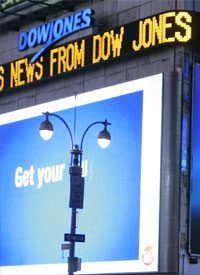
Down, down, down goes the Dow (and all the other stock indexes), and how much further the markets are likely to fall before the recession bottoms out is becoming an increasingly vexed question. The Dow is now well below 7,000 for the first time in 12 years, and bearish market analysts are now wondering: is Dow 5,000 a reasonable expectation? 4,000? Or lower still?
Time was when a three 300-point decline, such as the Dow experienced on Monday, was a negligible glitch against a backdrop of 12,000 or 13,000, but Monday’s loss amounted to well over four percent, similar percentagewise to the big one-day losses we saw last fall when the panic first began gathering steam.
The last great bear market, in 1974, saw stocks lose roughly 50 percent of their value before rebounding over the next several years. The Panic of 1907 also saw about a 50-percent market decline over less than a year. We’ve already seen a more than a 50-percent decline since the market hit all-time highs in 2007, and the torrent of bad news, from ill-advised government bailouts to disastrous earnings reports, continues unabated. Well might we wonder whether the ongoing crisis will be considerably more severe than those in ’74 or ’07; the evidence increasingly suggests that it will be.
From 1929 to mid-1932, at the onset of the Great Depression, the Dow fell from a high of about 380 to a low of about 40, a decline of nearly 90 percent. A similar collapse now would leave the Dow at around the 1,500 mark, a seemingly implausible outcome. More recently, Japan’s Nikkei index, after peaking at around 39,000 in late 1989, declined over the next 13 years to around 7,800, an 80-percent loss. After regaining some of its lost ground, the Nikkei is now back in the cellar, sounding new post-1989 lows. Also of interest is that the Nikkei lost about 50 percent of its value through June 1992, then leveled off, more or less, until March 2000 (when the dot.com bubble burst), when it resumed its downward trajectory.
It’s hardly surprising that some analysts are starting to use the “D” word — depression. Where it will all end is anybody’s guess, especially with the U.S. government and other governments around the world trying vainly to re-inflate the glorious bubble. This is precisely what the United States tried to do in the ’30s and Japan tried to do from 1989 to the present day, by running up huge debts, raising taxes, and pouring money into bailouts and public works projects. In the end, things only got worse and worse. For the United States, the end of the Great Depression finally came in the wake of World War II, when, for probably the last time, the federal government actually cut spending by about 30 percent — precisely the thing they should have done more than a decade earlier. The result was the fabled postwar economic boom.
At the same time, it’s important to realize that a protracted depression need not spell the end of the world. The last Great Depression ended very badly indeed for most of the world, but Japan’s more recent experience has in no way undercut the fundamental vitality of Japanese industry and innovation. The Japanese have now become one of the world’s thriftiest people, having learned by recent experience the pitfalls of excessive debt. The bursting of Japan’s “babaru keizai” punctured many illusions, but did not spell the downfall of that eminently practical and industrious nation. Let us hope that the outcome for the United States will be similar.
— Photo: AP Images



